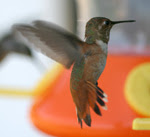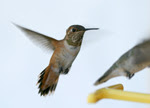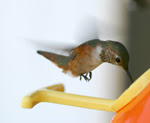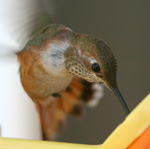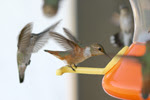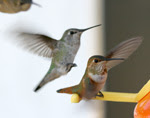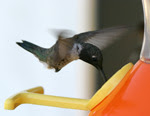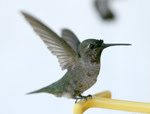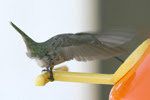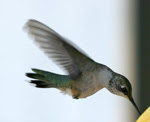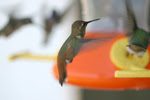Last night just before sundown, and again this morning just after sunrise, I did something I’ve been doing a lot of recently — enjoying the company of hummingbirds. At that time of day (and also just after sunrise in the morning), we have a hundred or more hummingbirds feeding from about eight large feeders in our windows (each holds a quart or more of sugar water). Usually we just watch them through the windows, but a few years ago — after a few years of feeding them — we noticed that the hummingbirds were getting acclimated to our presence in their midst. They’d buzz around excitedly as we put newly-filled feeders out. A few times one of them landed on my hat, glasses, head, or (most memorably) ear. They’d zip away if we made a sudden move, but if we were still or moved very slowly, they’d come back.
Nowadays, especially in the morning and evening, if we go out and stand still next to the feeders we’ll have clouds of hummingbirds around us within 30 seconds. Some of our feeders are hung at eyeball level. If I stand so that my nose is just two or three inches from the feeder, the hummingbirds will soon be feeding right in front of my nose, quite literally. They’re so close I have to take my glasses off to see them clearly — but oh, what a view I have of them then! Some of them are very curious, and will hover right in front of my face, a couple inches away, inspecting me. Others will hover over the feeder, drinking “nectar”. And others yet will land on the feeder before drinking.
My favorite, at this close range, are the female Allen’s or Rufous hummingbirds. These species are very hard (for me, at least!) to tell apart. Both Sibley’s and the San Diego Bird Atlas tell me that I really shouldn’t be seeing either species here this time of year — but they are most definitely here; those are the only two species that look anything like the birds we’re observing. For some reason it is much more common for us to see the females at our feeders, though we do see the (rather spectacular) males a few times every day. But the females are my favorite, with their softer, more varied colors and patterns.
While watching these tiny critters there are many things to marvel at. One skill particularly fascinates me: their ability to hover such that their heads are absolutely still. The rest of their little bodies are vibrating and oscillating as they correct for wind and turbulence, but their heads are rock-steady. This skill is key to their feeding — it lets them insert their long beaks and tongues deep into flowers, to slurp up the nectar within them. It’s just amazing how good at it they are. This would be extremely difficult for any man-made machine to duplicate…
This morning I had two pairs of males battling within a foot of my face. A pair of Anna’s, with their bright red “helmets", had an extended contest; one of them was particuarly aggressive, attacking not only with his beak but with his feet. The other was a pair of diminutive black-chinned males. These are badly misnamed, as their most prominent feature isn’t the black chin, but rather their extraordinary royal purple throats. These two held a spectacular aerobatic display just six inches from my eyeballs, tumbling about and doing somersaults that just looked impossible. Of course, they made it look very easy indeed!
Both last night and this morning, I spent part of my time with the hummers in the company of one of our cats: Maka Lea, our little neurologically damaged kitty. He has trouble walking and jumping, but is otherwise quite normal (although he still has the playful personality of a kitten). He just loves to watch the hummingbirds, as do all our cats — but unlike them, he doesn’t have the physical skills to leap and try to catch them. None of the cats seem to understand about windows, so they keep trying even though it’s not possible. So I take Maka Lea out with me when I commune with the hummers. I hold him upside-down in my arms, bundling his paws up so he can’t reach out and snag one as they flit by. But his head is swiveling all over as he watches them, eyes big and round. He is clearly enjoying himself. The hummers couldn’t care less about his presence — they will zip down to within an inch or so of his face, with no apparent concern or caution. Most likely this is only because I’m holding him, and the hummers don’t realize there’s anything but me. Eventually Maka Lea can’t stand it any more, and he’ll start struggling to escape my containment — that’s when I put him back indoors. But when he sees me heading for the door to go commune with the hummers, Maka Lea will come trotting up to my feet, look up at me, and mewl — it isn’t hard to figure out what he wants…
